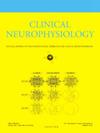Multivariate empirical mode decomposition reveals markers of Alzheimer’s Disease in the oscillatory response to transcranial magnetic stimulation
IF 3.6
3区 医学
Q1 CLINICAL NEUROLOGY
引用次数: 0
Abstract
Objective:
To investigate EEG activity following transcranial magnetic stimulation (TMS) of the dorsolateral prefrontal cortex of Alzheimer’s Disease (AD) patients and control subjects using a data-driven characterization of brain oscillatory activity without prescribed frequency bands.
Methods:
We employed multivariate empirical mode decomposition (MEMD) to analyze the TMS-EEG response of 38 AD patients and 21 control subjects. We used the distinct features of EEG oscillatory modes to train a classification algorithm, a support vector machine.
Results:
AD patients exhibited a weakened slow-frequency response. Faster oscillatory modes displayed a biphasic response pattern in controls, characterized by an early increase followed by a widespread suppression, which was reduced in AD patients. Classification achieved robust discrimination performance (85%/23% true/false positive rate).
Conclusions:
AD causes an impairment in the oscillatory response to TMS that has distinct features in different frequency ranges. These features uncovered by MEMD could serve as an effective EEG diagnostic marker.
Significance:
Early detection of AD requires diagnostic tools that are both effective and accessible. Combining EEG with TMS shows great promise. Our results and method enhance TMS-EEG both as a practical diagnostic tool, and as a way to further our understanding of AD pathophysiology.
多元经验模式分解揭示了阿尔茨海默病在经颅磁刺激振荡反应中的标记
目的:研究经颅磁刺激(TMS)对阿尔茨海默病(AD)患者和对照组背外侧前额叶皮层的脑电活动,采用数据驱动的无规定频带脑振荡活动表征。方法:采用多变量经验模式分解(MEMD)对38例AD患者和21例对照者的TMS-EEG反应进行分析。我们利用脑电图振荡模式的不同特征来训练一种分类算法——支持向量机。结果:AD患者表现出较弱的慢频反应。在对照组中,更快的振荡模式显示出双相反应模式,其特点是早期增加,随后广泛抑制,在AD患者中减少。分类实现了稳健的识别性能(85%/23%的真/假阳性率)。结论:AD引起的经颅磁刺激振荡反应损伤在不同频率范围内具有不同的特征。MEMD发现的这些特征可作为脑电图诊断的有效标志。意义:早期发现阿尔茨海默病需要既有效又容易获得的诊断工具。脑电图与经颅磁刺激相结合具有广阔的应用前景。我们的结果和方法增强了TMS-EEG作为一种实用的诊断工具,并进一步加深了我们对阿尔茨海默病病理生理学的理解。
本文章由计算机程序翻译,如有差异,请以英文原文为准。
求助全文
约1分钟内获得全文
求助全文
来源期刊

Clinical Neurophysiology
医学-临床神经学
CiteScore
8.70
自引率
6.40%
发文量
932
审稿时长
59 days
期刊介绍:
As of January 1999, The journal Electroencephalography and Clinical Neurophysiology, and its two sections Electromyography and Motor Control and Evoked Potentials have amalgamated to become this journal - Clinical Neurophysiology.
Clinical Neurophysiology is the official journal of the International Federation of Clinical Neurophysiology, the Brazilian Society of Clinical Neurophysiology, the Czech Society of Clinical Neurophysiology, the Italian Clinical Neurophysiology Society and the International Society of Intraoperative Neurophysiology.The journal is dedicated to fostering research and disseminating information on all aspects of both normal and abnormal functioning of the nervous system. The key aim of the publication is to disseminate scholarly reports on the pathophysiology underlying diseases of the central and peripheral nervous system of human patients. Clinical trials that use neurophysiological measures to document change are encouraged, as are manuscripts reporting data on integrated neuroimaging of central nervous function including, but not limited to, functional MRI, MEG, EEG, PET and other neuroimaging modalities.
 求助内容:
求助内容: 应助结果提醒方式:
应助结果提醒方式:


